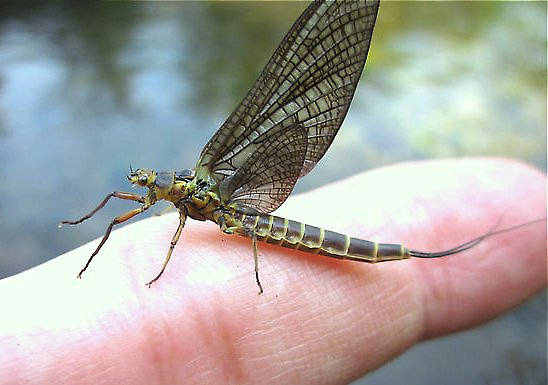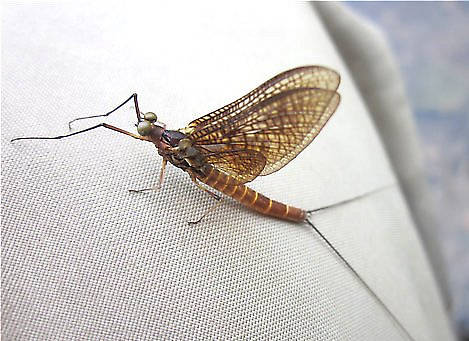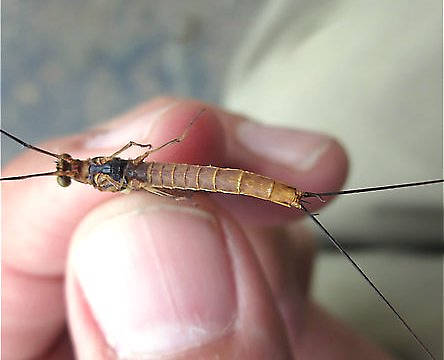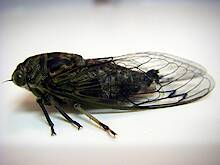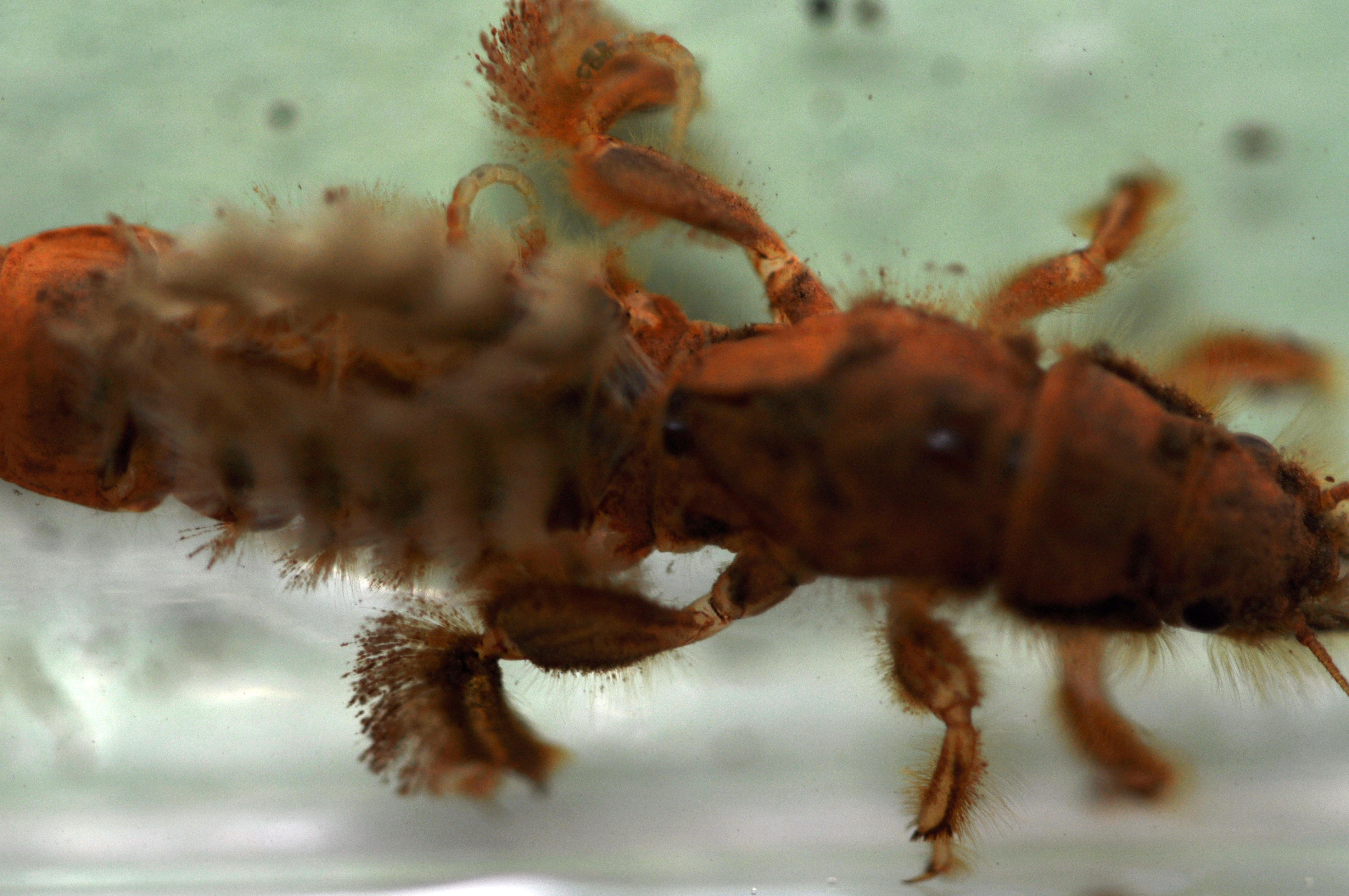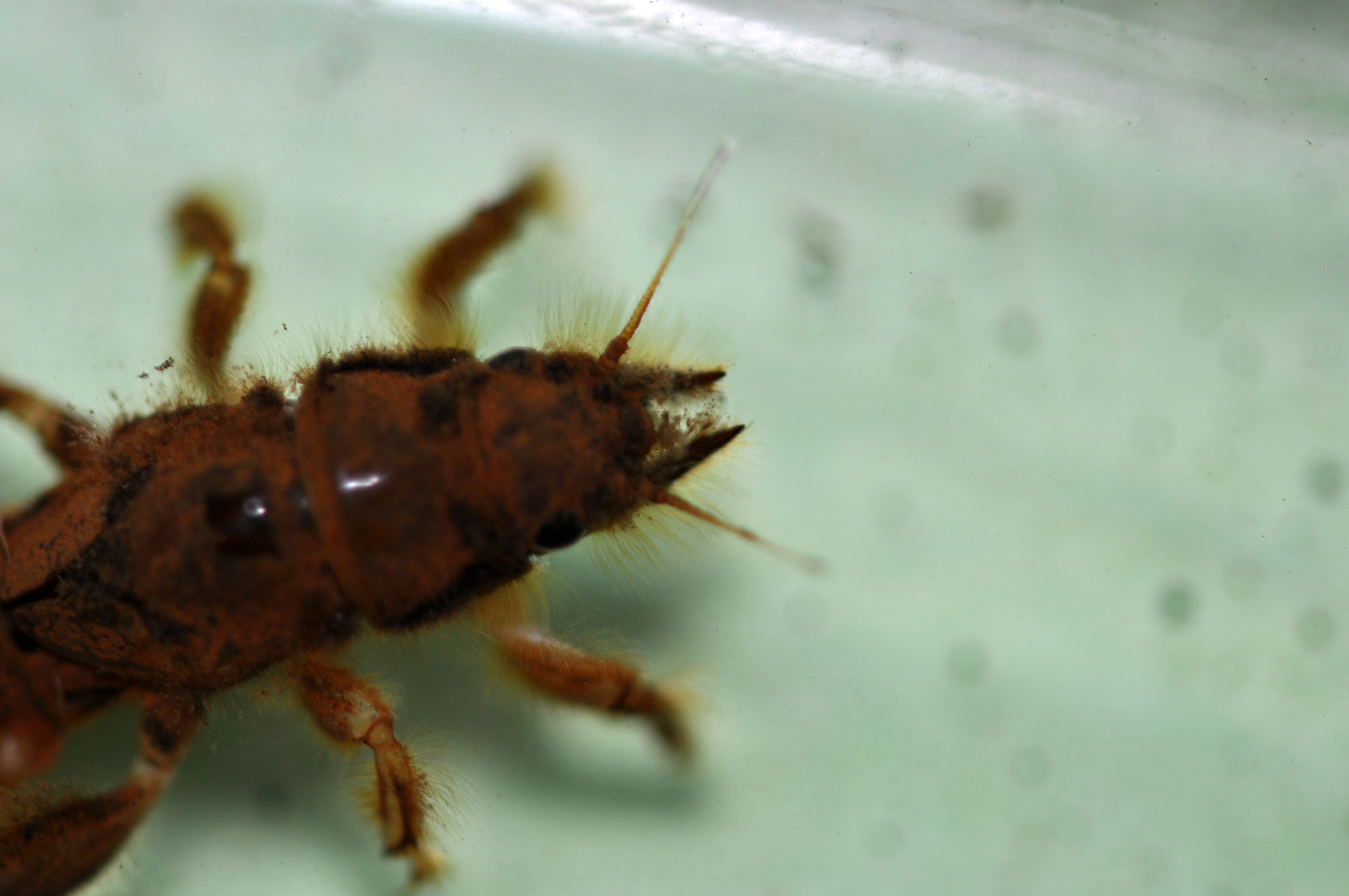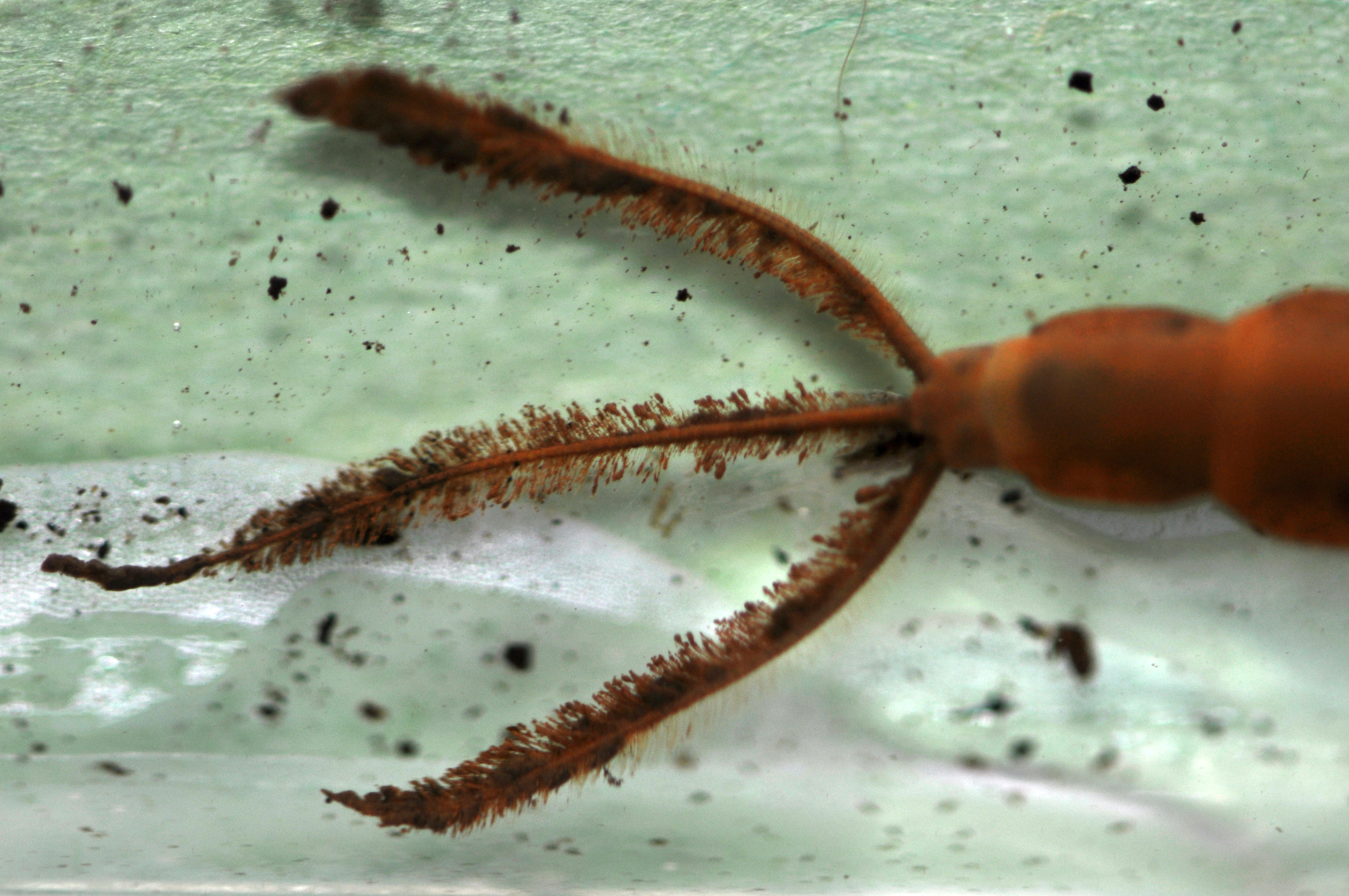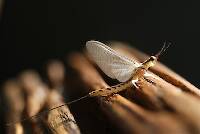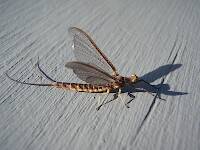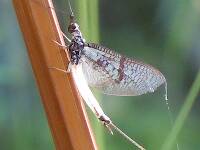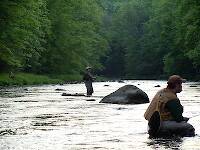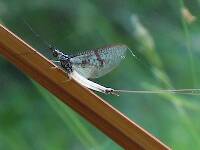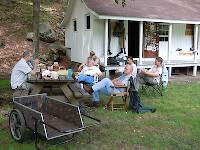
Salmonflies
Pteronarcys californica
The giant Salmonflies of the Western mountains are legendary for their proclivity to elicit consistent dry-fly action and ferocious strikes.
Featured on the forum

This is an interesting one. Following the keys in Merritt R.W., Cummins, K.W., and Berg, M.B. (2019) and Jacobus et al. (2014), it keys clearly to Ephemerella. Jacobus et al provide a key to species, but some of the characteristics are tricky to interpret without illustrations. If I didn't make any mistakes, this one keys to Ephemerella mucronata, which has not previously been reported any closer to here than Montana and Alberta. The main character seems to fit well: "Abdominal terga with prominent, paired, subparallel, spiculate ridges." Several illustrations or descriptions of this holarctic species from the US and Europe seem to match, including the body length, tarsal claws and denticles, labial palp, and gill shapes. These sources include including Richard Allen's original description of this species in North America under the now-defunct name E. moffatae in Allen RK (1977) and the figures in this description of the species in Italy.

Troutnut is a project started in 2003 by salmonid ecologist Jason "Troutnut" Neuswanger to help anglers and
fly tyers unabashedly embrace the entomological side of the sport. Learn more about Troutnut or
support the project for an enhanced experience here.
This topic is about the Mayfly Species Litobrancha recurvata
Litobrancha recurvata is generally reported to be the largest North American species of mayfly in angler entomologies, though this understanding is being challenged by reports of Hexagenia limbata that may exceed 40mm in some locales. Regardless, it is certainly the largest mayfly in the region of its distribution. Sometimes it appears together with species of Hexagenia or Ephemera, but in other places it creates excellent action on its own.Example specimens
DayTripper on Apr 6, 2013April 6th, 2013, 8:45 am EDT
Okay, I'm at a local TU meeting and a friend tells me about a double secret mystery hex hatch. According to him, these hex are colored differently than our limbata, hatch two or three weeks earlier for about 3 days only (last week of May or the first week of June), and exhibit some other "different" behavior traits. Needless to say, I was interested in learning more. Fast forward to this morning when I picked one of the nymphs up from his house after he dug a sample up for me to take home. Its still alive, so I'm trying to figure out what body parts I need photographs of to share here to see what you guys think this guy is.
A quick look at the head and tusks is pointing me to Litobrancha recurvata, and the emergence period shown in Hatches II for them is about right (May 14 to July 3). The photo they have in their color plates looks very close to what I just finished photographing, but what I have looks different.
I took a couple dozen quick photos of it and uploaded them to my flickr account, wasn't sure if it was ok or necessary to upload them all here. Link to the gallery below. Please let me know if you'd like me to upload any of these here, or if you'd like a better shot of a certain feature, so you can see the full res photo for better detail. In my non-expert opinion, I would say this nymph is near full maturity, as its ginormous. I can't find my metric ruler, but it is ~50mm long. Thanks for any help.
http://www.flickr.com/photos/cerveniak/sets/72157633180659254/
Alex
A quick look at the head and tusks is pointing me to Litobrancha recurvata, and the emergence period shown in Hatches II for them is about right (May 14 to July 3). The photo they have in their color plates looks very close to what I just finished photographing, but what I have looks different.
I took a couple dozen quick photos of it and uploaded them to my flickr account, wasn't sure if it was ok or necessary to upload them all here. Link to the gallery below. Please let me know if you'd like me to upload any of these here, or if you'd like a better shot of a certain feature, so you can see the full res photo for better detail. In my non-expert opinion, I would say this nymph is near full maturity, as its ginormous. I can't find my metric ruler, but it is ~50mm long. Thanks for any help.
http://www.flickr.com/photos/cerveniak/sets/72157633180659254/
Alex
Entoman on Apr 6, 2013April 6th, 2013, 9:44 am EDT
Hi Alex -
By all means, post a few of the photos here! Hi-resolution shots of the habitus (full body) are always good, but photos focusing on salient features are cool too.
From what I can see in your links, the nymph is indeed Litobrancha recurvata (Dark Green Drake). What differentiates it from closely related Hexagenia species is the combination of small unforked gills on the first abdominal segment and the hairless looking antennae. Being a monotypical genus in the Nearctic, there's no confusion caused by other species possibilities. The great size you mention (>40mm) is not surprising as this taxon is generally considered our largest mayfly. I agree the specimen is this year's hatch.
From an angler's perspective, your report about duration and timing is in line with others. An important behavioral difference seems to be that they are more prone to diurnal (daytime) availability than the more common Hexes. Unfortunately, they are relatively rare. Anglers that locate their isolated populations are usually very secretive about them. We have several regular contributors that have obliquely mentioned familiarity with the species and then clammed up.:)LOL
By all means, post a few of the photos here! Hi-resolution shots of the habitus (full body) are always good, but photos focusing on salient features are cool too.
From what I can see in your links, the nymph is indeed Litobrancha recurvata (Dark Green Drake). What differentiates it from closely related Hexagenia species is the combination of small unforked gills on the first abdominal segment and the hairless looking antennae. Being a monotypical genus in the Nearctic, there's no confusion caused by other species possibilities. The great size you mention (>40mm) is not surprising as this taxon is generally considered our largest mayfly. I agree the specimen is this year's hatch.
From an angler's perspective, your report about duration and timing is in line with others. An important behavioral difference seems to be that they are more prone to diurnal (daytime) availability than the more common Hexes. Unfortunately, they are relatively rare. Anglers that locate their isolated populations are usually very secretive about them. We have several regular contributors that have obliquely mentioned familiarity with the species and then clammed up.:)LOL
"It's not that I find fishing so important, it's just that I find all other endeavors of Man equally unimportant... And not nearly as much fun!" Robert Traver, Anatomy of a Fisherman
Crepuscular on Apr 6, 2013April 6th, 2013, 6:02 pm EDT
Anglers that locate their isolated populations are usually very secretive about them. We have several regular contributors that have obliquely mentioned familiarity with the species and then clammed up.:)LOL
I know something I won't tell...
http://www.troutnut.com/topic/6693/Litobrancha-recurvata
Entoman on Apr 6, 2013April 6th, 2013, 6:24 pm EDT
See what I mean?:)
"It's not that I find fishing so important, it's just that I find all other endeavors of Man equally unimportant... And not nearly as much fun!" Robert Traver, Anatomy of a Fisherman
DayTripper on Apr 8, 2013April 8th, 2013, 7:05 pm EDT
Entoman on Apr 9, 2013April 9th, 2013, 12:06 pm EDT
My understanding is that they are quite hardy (for mayflies). With the right advice, you should be successful. Some years ago we had a regular contributor who was an expert with these critters and raised them for professional academic purposes. Google him up to glean what you can. Fittingly, he went by the handle "Litobrancha." BTW, google from inside Troutnut (the box is in the upper right hand corner) not from your browser tabs or tool bar. This will limit your search to posts and topics on this site.
The photos that you and Eric posted look remarkably similar for critters taken that isolated from each other. Big Hex nymphs and emergers in cinnamon should be the ticket. I assume that it is a good bet that the duns and spinners are also the same in their coloration. If you want to raise the nymph to see what the adult looks like, Spence has provided some photos of this species that are featured on its hatch page.
The photos that you and Eric posted look remarkably similar for critters taken that isolated from each other. Big Hex nymphs and emergers in cinnamon should be the ticket. I assume that it is a good bet that the duns and spinners are also the same in their coloration. If you want to raise the nymph to see what the adult looks like, Spence has provided some photos of this species that are featured on its hatch page.
"It's not that I find fishing so important, it's just that I find all other endeavors of Man equally unimportant... And not nearly as much fun!" Robert Traver, Anatomy of a Fisherman
Oldredbarn on Apr 10, 2013April 10th, 2013, 4:38 am EDT
I know something I won't tell...
Eric...like where Spence is hiding out these days? ;)
The Lost Dutchman
"Even when my best efforts fail it's a satisfying challenge, and that, after all, is the essence of fly fishing." -Chauncy Lively
"Envy not the man who lives beside the river, but the man the river flows through." Joseph T Heywood
"Envy not the man who lives beside the river, but the man the river flows through." Joseph T Heywood
Martinlf on Apr 10, 2013April 10th, 2013, 11:15 am EDT
Hey, I know where Spence is hiding out today, but I won't tell that either. Suffice it to say, he's catching Pennsylvania trout.
"He spread them a yard and a half. 'And every one that got away is this big.'"
--Fred Chappell
--Fred Chappell
Oldredbarn on Apr 14, 2013April 14th, 2013, 5:46 pm EDT
Hey, I know where Spence is hiding out today, but I won't tell that either. Suffice it to say, he's catching Pennsylvania trout.
With a little help from my friends...
"Even when my best efforts fail it's a satisfying challenge, and that, after all, is the essence of fly fishing." -Chauncy Lively
"Envy not the man who lives beside the river, but the man the river flows through." Joseph T Heywood
"Envy not the man who lives beside the river, but the man the river flows through." Joseph T Heywood
Quick Reply
Related Discussions
Topic
Replies
Last Reply
3
May 31, 2016
by Oldredbarn
by Oldredbarn
1
Aug 1, 2008
by Troutnut
by Troutnut
6
Jul 28, 2012
by Entoman
by Entoman


